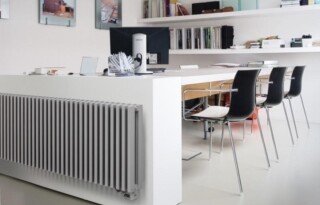Deciding between radiators or convectors is not strictly a technical matter for heating experts. To a large degree, the decision determines the sense of comfort in your home. How exactly? Read on and find out!
What is the difference between radiators and convectors?
The difference between radiators and convector lies in the convective heat which only the latter type of units generates. Radiators give off radiant heat, whereas convectors deliver convective heat. Convection is a difficult word for the transfer of heat through the air. In this process, the convector heats up air particles, which then rise, cool down and ultimately end up descending again. The hot and cold particles get mixed up, causing the entire room to feel warm after a while.
Radiant heat
Just about every way to heat your home to a degree is based on the principle of convective heat. In other words, radiators too generate convective heat. Yet, radiators do more than just heat up the air. They also give off a second type of heat, known as radiant heat. Radiant heat is a direct type of energy. The fact of the matter is that radiators, much like the sun, radiate electromagnetic waves. When these waves hit on a surface – such as a piece of furniture or your own body – they are converted into heat. This makes radiators feel pleasant to the touch, even though they are not generating any more or any less heat energy than other heat sources.
The comfort of radiators
All of this means that radiators deliver greater comfort than convectors, which are less efficient and do not give you that nice, snug feeling of deep intense warmth that a stove, an open fire or a radiator will deliver. Courtesy of their radiant heat, radiators are also perfectly suited to hang towels or pyjamas on to dry – a very pleasant little extra in your bathroom!
Another strong suit of radiators is that they do not disrupt the look and feel of your home interior. Quite the contrary! Going for designer radiators means going for a unique style that only enhances your interior, enabling you to effortlessly blend comfort, sustainability and aesthetics.
